The Cleaning Robot Market is estimated to be valued at USD 14.8 billion in 2025 and is projected to reach USD 96.8 billion by 2035, registering a compound annual growth rate (CAGR) of 20.6% over the forecast period.
The cleaning robot market is expanding rapidly, driven by increasing automation in household and commercial cleaning processes, rising labor costs, and growing consumer preference for time-saving solutions. Technological advancements in artificial intelligence, sensor-based navigation, and voice-assisted control have significantly enhanced operational efficiency and user experience.
The market benefits from urbanization, smaller living spaces, and the increasing affordability of robotic systems. Manufacturers are focusing on multi-surface cleaning capabilities and improved battery performance to strengthen market competitiveness.
Additionally, the rise in hygiene awareness post-pandemic has accelerated adoption across both residential and professional segments. With expanding distribution through online and retail channels and continuous innovation in connectivity features, the market outlook remains strong, supported by sustained demand for smart and autonomous cleaning solutions across diverse environments.
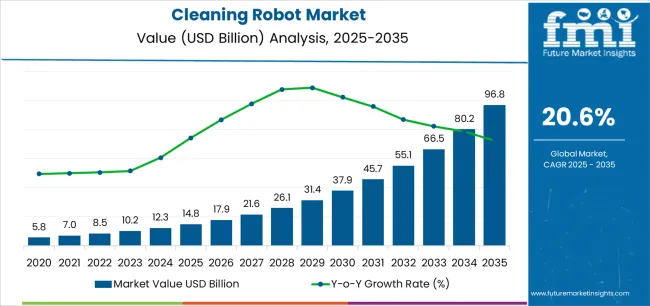
| Metric | Value |
|---|---|
| Cleaning Robot Market Estimated Value in (2025 E) | USD 14.8 billion |
| Cleaning Robot Market Forecast Value in (2035 F) | USD 96.8 billion |
| Forecast CAGR (2025 to 2035) | 20.6% |
The market is segmented by Type, Product, and Application and region. By Type, the market is divided into Professional Cleaning Robot and Personal Cleaning Robot. In terms of Product, the market is classified into Floor-Cleaning Robot, Lawn-Cleaning Robot, Pool-Cleaning Robot, Window-Cleaning Robot, and Others. Based on Application, the market is segmented into Residential, Commercial, Industrial, and Others. Regionally, the market is classified into North America, Latin America, Western Europe, Eastern Europe, Balkan & Baltic Countries, Russia & Belarus, Central Asia, East Asia, South Asia & Pacific, and the Middle East & Africa.
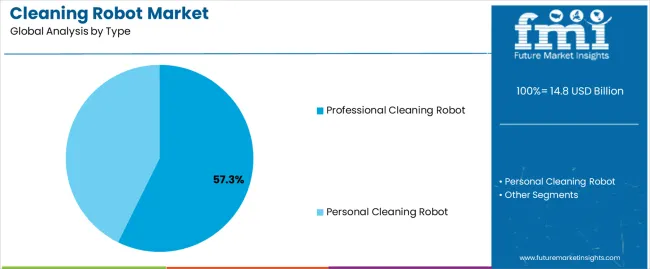
The professional cleaning robot segment leads the type category, accounting for approximately 57.3% share of the cleaning robot market. This dominance is driven by the segment’s increasing deployment in commercial spaces such as airports, offices, hospitals, and retail outlets, where high hygiene standards and cost efficiency are prioritized.
These robots provide consistent cleaning performance, reduced operational downtime, and lower long-term maintenance costs compared to manual labor. Their adoption is further reinforced by advancements in mapping technologies and self-docking capabilities, which allow large-area coverage and autonomous operation.
The segment also benefits from the expansion of service-based cleaning contracts and the integration of Internet of Things (IoT) for performance monitoring. With businesses emphasizing productivity and sustainability, professional cleaning robots are expected to maintain their leadership through continued technological upgrades and growing end-user reliance on automation.
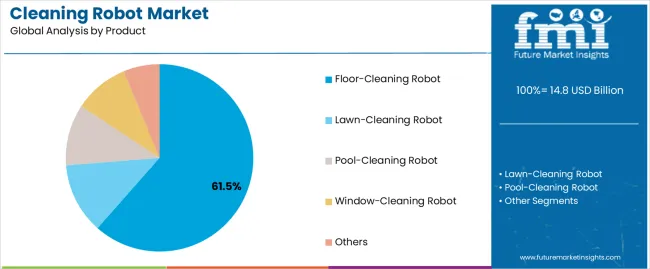
The floor-cleaning robot segment dominates the product category with approximately 61.5% share. Its leadership is supported by strong consumer acceptance and broad applicability across both residential and commercial environments. These robots are designed for efficient dust and debris removal from various floor types, including hardwood, tiles, and carpets, enhancing convenience for users.
Improved navigation algorithms, obstacle detection, and automatic recharging have increased their appeal. The segment benefits from growing competition among major brands, resulting in better affordability and performance features.
Continuous innovation, such as wet-and-dry hybrid models and self-emptying mechanisms, further drives adoption. With ongoing urbanization and the popularity of smart home ecosystems, the floor-cleaning robot segment is poised to sustain its leading position throughout the forecast period.
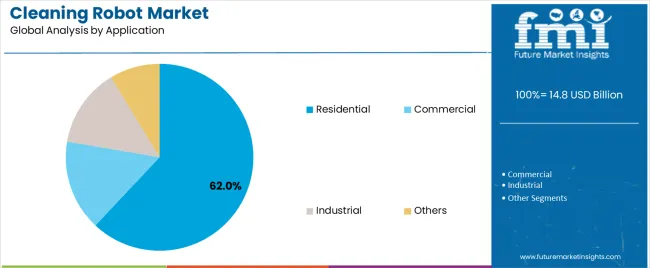
The residential segment holds approximately 62.0% share of the application category in the cleaning robot market. The dominance of this segment is primarily attributed to rising disposable incomes, increasing awareness of smart home devices, and a growing preference for automated domestic cleaning solutions.
Consumers are embracing robotic cleaners for their ability to perform routine cleaning efficiently with minimal supervision. Integration with mobile apps and voice assistants has enhanced accessibility and convenience, supporting higher penetration in urban households.
The segment’s growth is further reinforced by the availability of affordable models catering to diverse budgets and preferences. With rising emphasis on hygiene and time optimization, residential adoption is projected to expand steadily, securing the segment’s continued leadership in the coming years.
| Attributes | Details |
|---|---|
| Historical CAGR (2020 to 2025) | 25.9% |
The global cleaning robot market size expanded at a 25.9% CAGR from 2020 to 2025. The capabilities of cleaning robots have increased due to ongoing developments in robotics, artificial intelligence (AI), and sensor technologies.
Manufacturers are developing more complex and efficient versions, including improved navigation systems, sensors, and cleaning algorithms, contributing to greater customer interest and acceptance.
The trend toward smart homes is gaining traction, with customers looking for networked gadgets that can be managed and monitored from a centralized system. Modern cleaning robots that connect easily with smart home ecosystems have grown increasingly appealing to tech-savvy customers, resulting in market development.
Smart cleaning robots are increasingly being used in workplaces, hotels, healthcare institutions, and homes. The automation of cleaning procedures in these environments helps to drive market expansion. Collaborative cleaning robots and swarm cleaning robots are the current highlights in the market.
In the coming years, it is anticipated that cleaning robot designs are likely to continue prioritizing energy efficiency and sustainability. Manufacturers can look into green materials, energy-efficient components, and environmentally aware production techniques to keep up with the worldwide trend toward environmentally friendly goods.
Governments and business associations can potentially develop standards and laws pertaining to cleaning robots; they can contain provisions addressing environmental effects, data privacy, and safety. In the changing market scenario, producers could consider it crucial to comply with such criteria.
| Attribute | Details |
|---|---|
| Trends |
|
| Opportunities |
|
| Challenges |
|
| Top Type | Personal Cleaning Robot |
|---|---|
| Value CAGR (2025 to 2035) | 21.5% |
Based on type, the personal cleaning robot segment is predicted to expand at a 21.5% CAGR through 2035.
| Top Product | Floor-cleaning Robot |
|---|---|
| Value CAGR (2025 to 2035) | 21.3% |
Based on the product, the floor-cleaning robot segment is projected to thrive at a 21.3% CAGR through 2035.
| Countries | Value-based CAGR (2025 to 2035) |
|---|---|
| United States | 21.9% |
| United Kingdom | 23.0% |
| China | 22.4% |
| Japan | 22.8% |
| South Korea | 23.6% |
The demand for cleaning robots in the United States is anticipated to rise at a 21.9% CAGR through 2035.
Cleaning robot sales in the United Kingdom are projected to surge at a 23.0% CAGR through 2035.
The cleaning robot market in China is estimated to rise at a 22.4% CAGR through 2035.
The demand for cleaning robots in Japan is predicted to increase at a 22.8% CAGR through 2035.
The sales of cleaning robots in South Korea are estimated to rise at a 23.6% CAGR through 2035.
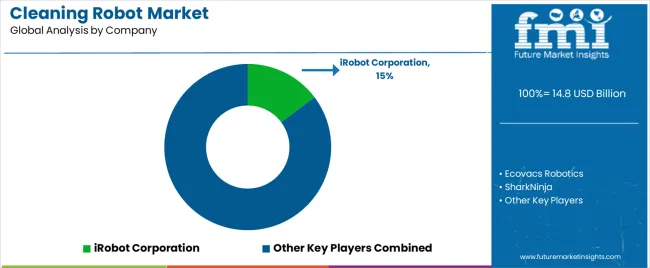
The cleaning robot market is incredibly competitive, with significant rivals contending for market dominance and technological superiority. A dynamic ecosystem is created by both well-established multinational corporations and agile startups, with innovation, brand awareness, and strategic alliances being vital elements.
Large international companies with well-established brands and broad product lines, like SharkNinja, Ecovacs Robotics, and iRobot Corporation, influence the market.
Recent Developments
The global cleaning robot market is estimated to be valued at USD 14.8 billion in 2025.
The market size for the cleaning robot market is projected to reach USD 96.8 billion by 2035.
The cleaning robot market is expected to grow at a 20.6% CAGR between 2025 and 2035.
The key product types in cleaning robot market are professional cleaning robot and personal cleaning robot.
In terms of product, floor-cleaning robot segment to command 61.5% share in the cleaning robot market in 2025.






Full Research Suite comprises of:
Market outlook & trends analysis
Interviews & case studies
Strategic recommendations
Vendor profiles & capabilities analysis
5-year forecasts
8 regions and 60+ country-level data splits
Market segment data splits
12 months of continuous data updates
DELIVERED AS:
PDF EXCEL ONLINE
Cleaning In Place Market Growth - Trends & Forecast 2025 to 2035
Cleaning and Hygiene Product Market Report – Demand & Trends 2024-2034
Dry Cleaning Solvents Market Size and Share Forecast Outlook 2025 to 2035
GMP Cleaning Services Market Analysis Size and Share Forecast Outlook 2025 to 2035
Dry-Cleaning and Laundry Services Market Growth, Trends and Forecast from 2025 to 2035
Self-Cleaning Bottle Market Analysis - Trends, Growth & Forecast 2025 to 2035
Hand Cleaning Accessories Market
Floor Cleaning and Mopping Machine Market Size and Share Forecast Outlook 2025 to 2035
Cable Cleaning Solutions Market Analysis - Size, Share, and Forecast Outlook 2025 to 2035
Cable Cleaning Equipment Market Analysis - Size, Share, and Forecast Outlook 2025 to 2035
Wafer Cleaning Equipment Market Growth - Trends & Forecast 2025 to 2035
Drain Cleaning Equipment Market Growth - Trends & Forecast 2025 to 2035
Medical Cleaning Devices Market Overview - Trends & Forecast 2025 to 2035
Thermal Cleaning System Market Growth - Trends & Forecast 2025 to 2035
Document Cleaning Powder Market Size and Share Forecast Outlook 2025 to 2035
Air Duct Cleaning Chemicals Market Size and Share Forecast Outlook 2025 to 2035
Aircraft Cleaning Chemicals Market 2025-2035
Wellbore Cleaning Tool Market Size, Share, Trend & Forecast 2024-2034
Enzymatic Cleaning Market – Demand, Innovations & Forecast 2025 to 2035
Beer Line Cleaning Kit Market Trend Analysis Based on Product, End-User, Type, and Region 2025 to 2035

Thank you!
You will receive an email from our Business Development Manager. Please be sure to check your SPAM/JUNK folder too.
Chat With
MaRIA